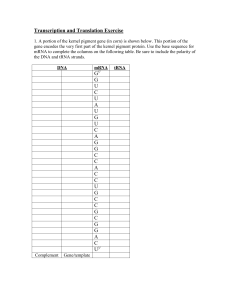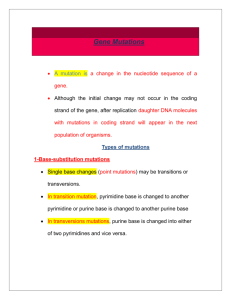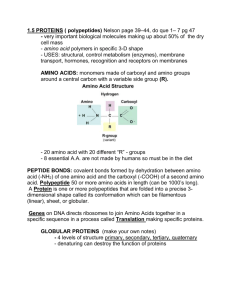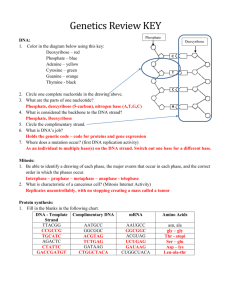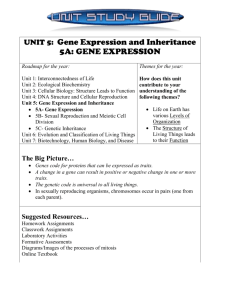Transcription and Translation Exercise
advertisement
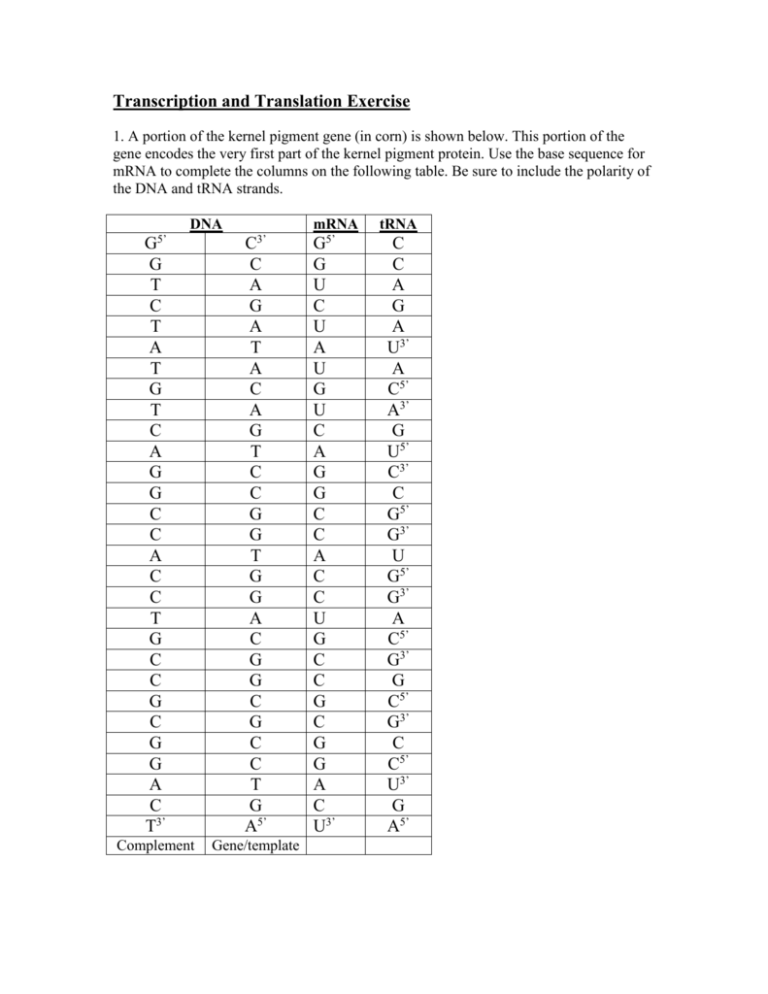
Transcription and Translation Exercise 1. A portion of the kernel pigment gene (in corn) is shown below. This portion of the gene encodes the very first part of the kernel pigment protein. Use the base sequence for mRNA to complete the columns on the following table. Be sure to include the polarity of the DNA and tRNA strands. DNA 5’ mRNA 3’ G G T C T A T G T C A G G C C A C C T G C C G C G G A C T3’ C C A G A T A C A G T C C G G T G G A C G G C G C C T G A5’ Complement Gene/template 5’ G G U C U A U G U C A G G C C A C C U G C C G C G G A C U3’ tRNA C C A G A U3’ A C5’ A3’ G U5’ C3’ C G5’ G3’ U G5’ G3’ A C5’ G3’ G C5’ G3’ C C5’ U3’ G A5’ 2. Describe the relationship between the gene sequence and the mRNA sequence. The gene sequence and the mRNA sequence are complements of each other. 3. Describe the relationship between the gene sequence and the tRNA sequence. They are the same except RNA contains U’s while DNA contains T’s. 4. If the coding region of a protein coding gene contains 300 DNA nucleotides, how many amino acids will be used in protein synthesis? 99 amino acids. Every three nucleotides = 1 amino acid, so 300/3 = 100, but the stop codon does not code for an amino acid, therefore 99 amino acids. 5. If a protein has 150 amino acids, how many DNA nucleotides would make up the coding region of the gene? 150 x 3 = 450, plus one codon for stop, 450 + 3 = 453. 6. What is the amino acid sequence for the very first part of the kernel pigment protein in the exercise above? Met-Ser-Gly-His-Leu-Pro-Arg-Thr 7. The allele of the gene above is dominant and codes for red kernel pigment (it is designated as R). Another allele of this gene, the r allele (which is recessive), codes for white kernel pigment and is the result of a mutation in the R allele. In the r allele, the second nucleotide (base) in the second codon of the open reading frame (or coding region) is an adenine. What does the second codon in the r allele code for? UCA becomes UAA = STOP 8. A protein has the following amino acid sequence. Construct a DNA nucleotide sequence of this portion of the gene. Phenylalanine-Glycine-Glycine-Alanine-Proline-Valine-Asparagine-Alanine There are multiple correct answers for this. 9. If you compared your sequence to one constructed by a classmate, would you expect to see any variations? What would be the reason for the difference? This is due to the redundancy or degeneracy of the code. (multiple codons code for the same amino acid) 10. Complete the following table: Nucleotide Components and Function Nucleic Acid Type DNA deoxyribose Name of the sugar present in nucleotides Name of bases present in nucleotides Function of the type of nucleic acid Describe the relative size and number of stands in each of the nucleic acids Where can you find each of these in a eukaryotic cell? mRNA tRNA ribose ribose Adenine, Guanine, Cytosine, Uracil Adenine, Guanine, Cytosine, Uracil Molecular middleman used in protein synthesis. Very, very large. Copy an of individual gene, used as instructions to synthesize a protein. Fraction of the genome size. nucleus Cytosol cytosol Adenine, Guanine, Cytosine, Thymine Storage of genetic info Relatively small.
